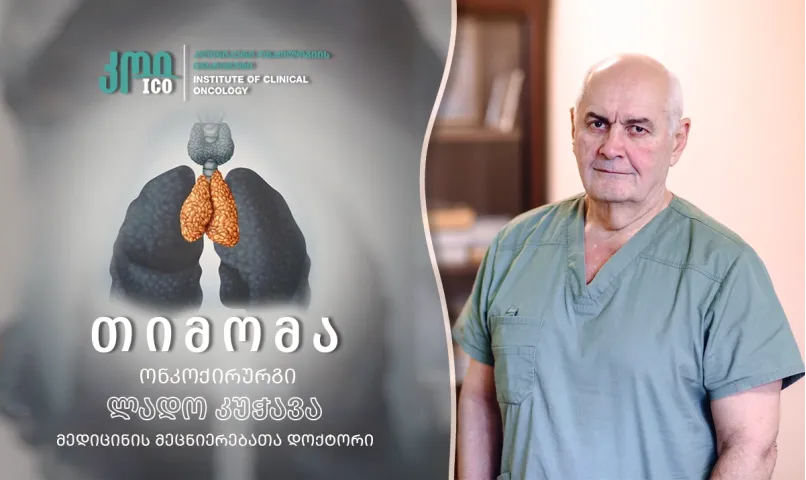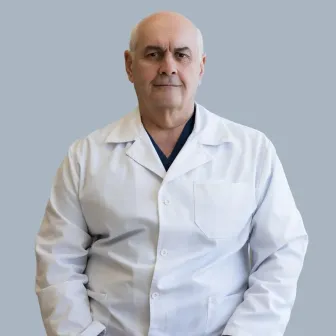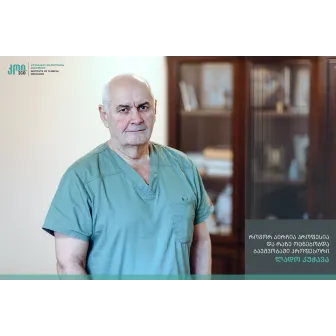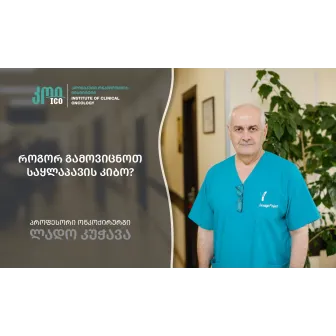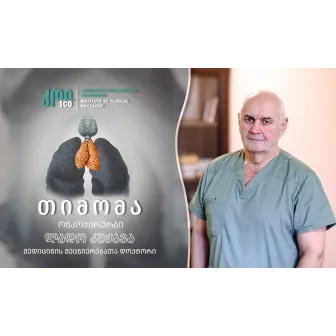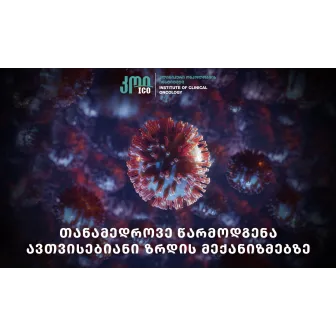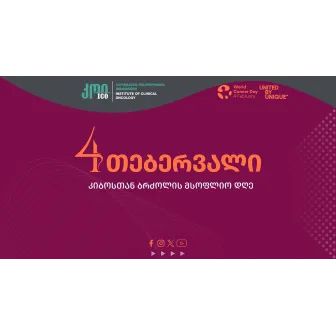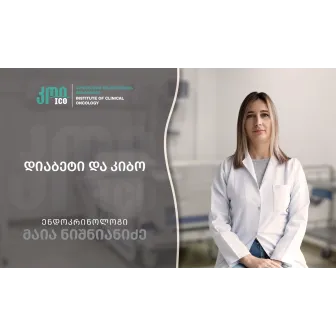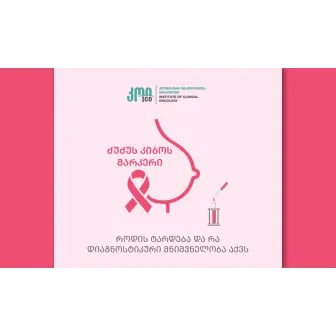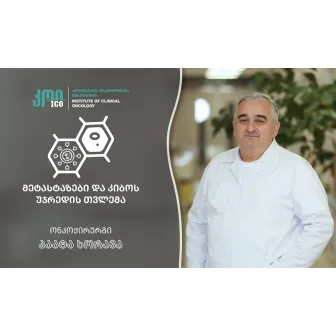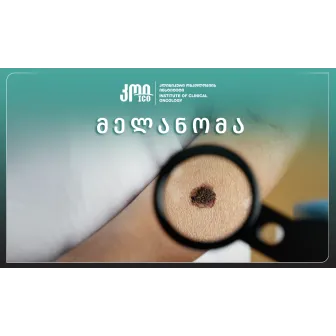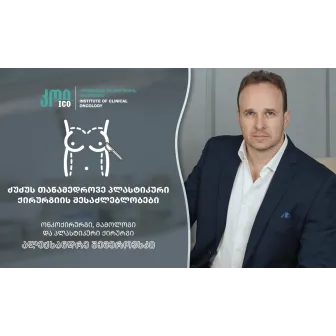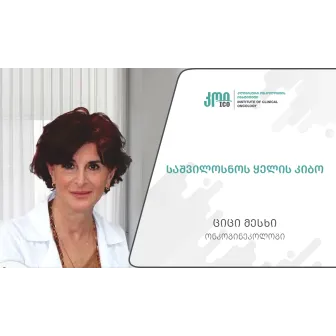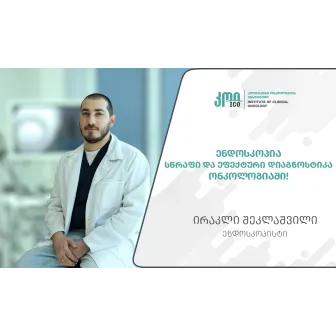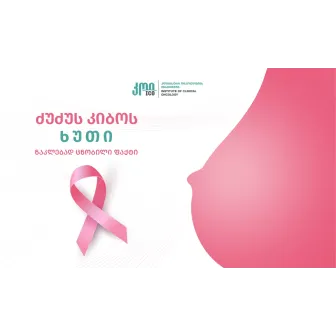What is thymoma, and how is it clinically manifested?
Thymic tumors, especially thymoma, are relatively rare but important conditions in clinical oncology. Recognizing their subtypes, identifying specific symptoms, and providing prompt, accurate diagnosis are crucial for effective disease management.
Lado Kutchava, a professor at the Institute of Clinical Oncology, discusses this topic with us.
Thymoma is a tumor that develops from thymic epithelium, located in the anterior superior mediastinum, and accounts for 45% of mediastinal tumors. The thymus is a primary lymphoepithelial organ involved in developing the adaptive immune response. It is situated in the anterior superior mediastinum and consists of two lobes—the right and left—covered by a capsule. Each lobe has an outer cortex rich in cells (including immature T lymphocytes, thymocytes, and epithelial cells) and an inner medulla that contains fewer epithelial cells (In the medullary layer, epithelial cells form clusters called Hassall's bodies) and lymphocytes.
In addition to thymocytes and epithelial cells, the thymus also contains dendritic cells, macrophages, a small quantity of B lymphocytes, neutrophils, and eosinophils. The thymus is supplied with blood by branches of the internal thoracic artery, the inferior phrenic artery, and rarely the superior phrenic artery. The veins leaving the thymus join either the jugular veins or directly to the superior vena cava. At birth, the thymus is an organ 4-6 cm long, 2.5-5 cm wide, and 1 cm thick. It grows in size to 20-50 g by puberty, and then undergoes involution (atrophies and is replaced by fatty tissue).
Risk factors for developing thymoma are not well understood. No specific etiological factor is known to contribute to its development. Thymoma is closely linked to paraneoplastic syndromes, including myasthenic syndrome, pure red cell aplasia, polymyositis, Cushing's syndrome, and syndrome of inappropriate antidiuretic hormone secretion. 50 % of patients with thymoma (arising from the cortical layer) develop myasthenic symptoms, while 15-20% of patients with myasthenia gravis have thymoma. The disease occurs with equal frequency in women and men and is most common in patients aged 40-70 years.
Pathophysiology and histological types. Thymoma is a malignant epithelial tumor of the thymus, which is mainly located in the anterior superior mediastinum behind the sternum. In some cases, thymoma can be located in the chest, thyroid gland, pulmonary hilum, lung, pleura, and pericardium. Examining macroscopically, thymoma is a well-circumscribed, homogeneous mass, the size of which can vary from 1 mm to 30 cm. The following histological types of thymomas are distinguished by the World Health Organization, taking into account the shape of the epithelial cells, atypia, and lymphocytic infiltration:
Type A Thymoma
- Consists of oval or spindle-shaped epithelial cells and an insignificant number of scattered lymphocytes.
- Considered as a medullary type thymoma and is characterized by a good prognosis (60% in stage I).
Type AB Thymoma
- Consists of cells characteristic of type A and B thymoma.
- Considered as mixed-type thymoma, and 67% of cases correspond to stage I.
Type B1 Thymoma
- Consists mainly of lymphocytes and a small number of scattered epithelial cells
- Considered as a cortical type thymoma
- 50% of cases correspond to stage I.
Type B2 Thymoma
- Predominantly consists of epithelial cells arranged in groups.
- In some cases, atypical degeneration of epithelial cells and neoplastic changes occur.
- 32% of cases correspond to stage I.
Type B3 Thymoma
- Predominantly consists of large atypical epithelial cells and scattered lymphocytes.
- Compared to other thymomas, its prognosis is bad, and only 19% correspond to stage I.
Thymoma features a lobular structure. Each lobule contains neoplastic cells and reactive lymphocytes, surrounded by a fibrous capsule.
Type A and AB thymomas are characterized by microcystic changes and a gland-like or papillary structure. These thymomas are called rhabdomyomatoid thymomas because of plasma infiltration and muscle tissue development. B1, B2, and B3 thymomas feature a dilated perivascular space containing plasma, a small number of lymphocytes, plasma cells, macrophages, and Hassall bodies (especially common in type B1 thymomas).
B1 and B2 thymomas exhibit extensive lymphocytic infiltration;
however, they have many histological differences. In B1 thymoma, regions of medullary infiltration (medullary islands) and scattered epithelial cells (<3 epithelial cells in groups) are observed, whereas B2 thymoma contains numerous clustered epithelial cells (>3 epithelial cells in groups). Immunohistochemical testing is crucial for distinguishing thymomas. Thymic epithelial cells test positive for keratin, epithelial membrane antigen, P40, P63, and PAX8. Thymomas are also characterized by low mutational activity.
The most common mutations in thymomas are:
- General transcription factor 1 (39-42%)
- P53(25-36%)
- KIT (6-20%)
- Cyclin-dependent Kinaze inhibitor (found in 11% in thymic carcinoma and B3 thymoma).
- In rare cases - n-ras, k-ras, cyclin 1, Ataxia-telangiectasia gene.
Clinical manifestation. Patients with thymoma can be divided into three groups according to clinical manifestations:
- Asymptomatic patients who were diagnosed with the disease by chance/incidentally, through imaging studies.
- Patients with symptoms due to local pressure/impact of the tumor on the thoracic cavity organs: cough, epigastric pain, tightness, dyspnea (often indicating tumor invasion of the mediastinal nerve).
- Patients with paraneoplastic syndrome.
The nature of the symptoms, developed as a result of pressure on the thoracic cavity organs by a tumor, is determined by both the tumor size, the organ it compresses, and the degree of compression. Clinically, symptoms are manifested in a cough, pain in the epigastric area, tightness, dyspnea (often indicates tumor invasion of the mediastinal nerve and its paralysis), superior vena cava syndrome (swelling of the face, neck, upper extremities, dyspnea, cough, the appearance of venous collaterals on the epigastric region). The occurrence of effusion in the pleural cavity or pericardium indicates an advanced form of the disease.
A certain part of patients with thymoma develop paraneoplastic syndrome. The most common among them is myasthenic syndrome, which can develop at any stage of the disease. Myasthenia gravis is a neuromuscular synapse disease in which autoantibodies against acetylcholine receptors on the postsynaptic membrane are produced (85% of cases). In patients with thymoma who develop myasthenia gravis, antibodies against titin and RyR (calcium channel receptor) receptors have also been observed in 95% of patients. The majority of these patients developed myasthenia gravis later in life (>50 years) and had a more severe clinical course and prognosis. Myasthenic syndrome is most commonly seen in thymomas arising from the cortical layer. By this time, neoplastic epithelial cells develop epitomas featuring cross-reactivity to the acetylcholine, RY, and titine receptors. Antibodies against the epitope presented by T lymphocytes, due to cross-reactivity, interact with these receptors and cause disruption of neuromuscular impulse transmission. Symptoms characteristic of myasthenia gravis include:
Antibodies against the epitope presented to T lymphocytes, due to cross-reactivity, interact with these receptors and disrupt neuromuscular impulse transmission. Symptoms characteristic of myasthenia gravis are:
- Weakness of extraocular muscles - ptosis, diplopia, or both. In 85% of cases, the first symptom is ptosis or diplopia.
- Bulbar muscle weakness - in 15% of cases, it is the first manifestation of the disease and includes: chewing difficulty, a feeling of choking when eating, dysphagia, hoarseness, and dysarthria. If the muscles of the face and neck are involved in the pathological process, changes in facial expression and "hanging head" syndrome develop.
- Limb weakness - weakness mainly develops in the proximal part of the upper limbs.
- Myasthenic crisis - myasthenic crisis is caused by the involvement of the intercostal muscles and diaphragm in the pathological process, which requires emergency care.
Other autoimmune diseases are also associated with thymoma. Pure red cell aplasia occurs in 5-15% of cases, and is most common in women over 60 years of age. 5% of patients with thymoma develop Hypogammaglobulinemia or white blood cell aplasia, leading to the development of immunodeficiency syndrome and recurrent infections, diarrhea, and lymphadenopathy. About 1% of patients develop thymoma-associated multiorgan autoimmunity, which is clinically manifested by skin hyperemia, chronic diarrhea, and elevated liver enzymes. Most of the thymoma-associated autoimmune diseases feature histologically distinct thymomas.
Diagnostics and staging. After a clinical evaluation of the patient, a computed tomography (CT) scan or magnetic resonance imaging (MRI) of the chest is necessary to diagnose thymoma. CT can assess the size, shape (mainly a smooth, well-defined tumor behind the sternum), location, and relationship to mediastinal organs. With MRI, it is possible to determine whether the tumor is cystic or solid and to evaluate its effect on adjacent organs. PET scanning is used if it is necessary to differentiate between thymoma and thymic carcinoma.
Along with imaging examinations, other laboratory tests are performed: germ cell markers (b-hCG and AFP), lymphoma diagnostic markers (LDH, CBC), and the acetylcholine receptor antibody test. The study of markers for lymphoma and germinal cell tumors is essential in the differential diagnosis of anterior mediastinal tumors. For final confirmation of the diagnosis, a morphological test of the tissue is necessary. There are several ways to do this. Surgical resection (in the case of small encapsulated tumors or large resectable tumors) or obtaining tissue by percutaneous biopsy or open biopsy when the tumor is unresectable, the patient requires neoadjuvant therapy, or the patient is not amenable to surgical treatment due to age and comorbidity. Percutaneous biopsy is performed under CT guidance. Open biopsy may be performed using thoracoscopic, cervical mediastinoscopy, anterior mediastinotomy (Chamberlain procedure), or endobronchial ultrasound.
It is necessary to make a differential diagnosis between thymoma and other tumors developing in the anterior mediastinum: thymic carcinoid tumor (often develops in patients with multiple endocrine neoplasia), thymic cysts (MRI studies show cystic structures in the thymus), non-Hodgkin lymphoma, germ cell tumors, tumors developing from ectopic parathyroid glands, goiters, and paragangliomas.
The Masaoka–Koga modified classification and the TNM classification are used for staging thymomas.
T Classification
- T1: Incapsulated tumor or extended to mediastinal fatty tissue.
- T1a: Without invasion into the mediastinal pleura.
- T1b: With invasion into the mediastinal pleura.
- T2: Partial or full invasion into the pericardium
- T3: Invasion into the lung, saphenous vein, superior vena cava, phrenic nerve, chest wall, extrapericardially into the pulmonary artery and vein
- T4: Invasion into the aorta (ascending, arch, descending), blood vessels emerging from the arch, intrapericardially into the pulmonary artery and vein, myocardium, trachea, and esophagus.
N and M classification
- N0: In lymph nodes without metastasis.
- N1: Metastases in lymph nodes around the thymus (prevascular, para-aortic, peritymuscular, and supradiaphragmatic).
- N2: Metastases in intrathoracic lymph nodes (Lymph nodes along the internal carotid artery, paratracheal, subaortic, subcarinal, and hilar lymph nodes).
- MO: N No advanced metastasis is detected.
- M1a: Single pleural or pericardial node(s)
- M1Bb Dissemination to the pleura and pericardium or metastases to distant organs
According to the TNM classification, the following staging has been developed:
- I Stage-T1 a/b N0, M0
- II Stage T2 N0 M0
- IIIA Stage T3 NO MO
- IIIB Stage T4 N0 M0
- IVA Stage any T, N1 M0
- IVA Stage any T N0, 1, M1a
- IVB Stage any T N2 M0 1a
- IVB Stage any T and N M1B
Masaoka–Koga clinical staging classification:
- I - Grossly and microscopically completely encapsulated tumor
- IIa - Microscopic transcapsular invasion
- IIb - Macroscopic invasion into thymic or surrounding fatty tissue, or grossly adherent to but not breaking through mediastinal pleura or pericardium
- III - Macroscopic invasion into neighboring organ (i.e., pericardium, great vessel, or lung), including one of the following:
Microscopic invasion of the mediastinal pleura
Microscopic invasion of the pericardium
Microscopic invasion of the visceral pleura or lung parenchyma
Invasion of the mediastinum and ostium
Invasion or complete penetration of large blood vessels
- Iva - Pleural or pericardial metastases (isolated from a tumor)
- IVb - Lymphogenous or hematogenous/extrathoracal metastasis
Treatment
Treatment of thymomas implies chemoradiotherapy, steroid therapy, immunotherapy, and surgical resection. Such a multidisciplinary approach increases the effectiveness of thymoma treatment. In resectable cases, when the encapsulated tumor or a tumor is invaded into resectable structures (pericardium, pleura, lung, etc.) the goal of surgical treatment is to achieve an R0 (no tumor infiltration at the resection margin) resection, which determines the long-term outcome of the disease. Classically, surgical treatment includes total thymectomy and lymphadenectomy. Classically, surgical treatment involves total thymectomy and lymphadenectomy. Intraoperatively, inflammatory fibrous tissue invasion into surrounding structures is often observed, resembling true tumor invasion. In such a case, it is necessary to mark the suspicious area and have it examined in detail by a pathologist. Patients with myasthenia gravis require preoperative preparation, consultation with a neurologist, in some cases, steroid therapy, plasmapheresis, intravenous immunoglobulin administration, and a plan for anesthesia induction, intubation, and extubation by an anesthesiologist. In addition to resectable cases, there are potentially resectable cases when the tumor invades structures such as the saphenous vein, median nerve, pericardium, and large blood vessels. A subset of such patients will require neoadjuvant chemotherapy/radiotherapy and postoperative radiotherapy. After neoadjuvant treatment, reassessment of resectability is necessary. In these cases, surgical treatment is more aggressive. Thymectomy is accompanied by resection of the invaded organs (pleurectomy, pericardial resection, lung resection or pneumonectomy, phrenic nerve resection, brachial vein resection, superior vena cava resection), followed by postoperative radiotherapy. In cases of completely unresectable tumors, the patient should undergo tumor debulking and postoperative radiotherapy (PORT). The goal of debulking is to reduce the size of the tumor and the area to be irradiated, to cause less damage to the mediastinal organs.
Cases are considered unresectable when there is pleural and pericardial dissemination of the tumor, invasion of large blood vessels (which cannot be resected and reconstructed), trachea, myocardium, and distant metastases (most often to the liver). Patients whose surgical treatment is impossible due to age or concomitant disease also belong to this group. In unresectable cases, palliative systemic therapy - radiotherapy, or chemoradiotherapy is provided.
There are three main approaches to performing thymectomy: median sternotomy (the most commonly used), transverse neck incision (transcervical thymectomy), and thoracoscopic approach. The boundaries of radical thymectomy are: lateral to the right and left phrenic nerves, inferior to the diaphragm, and superior to the phrenic-thymic ligament. As mentioned, R0 resection sometimes requires resection of the mediastinal pleura, pericardium, lung, brachial vein, and unilateral phrenic nerve. R1 and R2 resections are associated with an increased risk of local recurrence. During radical thymectomy, depending on the tumor invasion, either N1 or N2 lymphadenectomy is performed. In cases of invasion into mediastinal structures, N2 (subclavian, internal thoracic artery, superior and inferior paratracheal, subaortic, aortopulmonary, and pulmonary hilar) lymphadenectomy is performed. When encapsulated mediastinal structures are not invaded, N1 (perithymic, pericardial, and pre-thoracic lymphadenectomy) lymphodissection is performed.
Thymectomy post-operation complications
- Respiratory failure and prolonged intubation- often develops in patients with myasthenia gravis.
- Pleural effusion, pneumonia, pneumothorax, iatrogenic lung injury.
- Mediastinal and recurrent laryngeal nerve injury.
- Left recurrent laryngeal nerve damage - occurs during aortopulmonary window dissection, characterized by vocal cord paralysis.
- Right recurrent laryngeal nerve damage - develops during dissection of the right subclavian artery, characterized by paralysis of the vocal cords.
- Wound infection and mediastinitis - the likelihood of their development increases due to steroid therapy (in patients with myasthenia gravis)
Radiation oncology. The indications for postoperative radiotherapy in thymomas vary and depend on the stage of the disease and the degree of surgical resection. Stage I (Masaoka I): in which the capsule is not damaged, there is no need for PORT (only annual chest CT is required). Stage II (Masaoka II), in which the tumor tissue has invaded the mediastinal tissue and pleura, postoperative radiotherapy is recommended if the tumor is large and microscopic examination shows tumor infiltration at the resection margin. Stage III (Masaoka III) always requires postoperative radiation therapy due to the high risk of recurrence. In stage IV (Masaoka IV), radiation therapy is used as an initial treatment method, often palliative. Side effects of radiation therapy include: esophagitis, pneumonitis, pulmonary fibrosis, pericarditis, and transverse myelitis.
Prognosis. Thymoma is a slow-growing tumor. Its prognosis depends on the histological type of the tumor, the invasion/stage of surrounding organs, and the extent of resection.
- The prognosis for Masaoka I and II is very good, with full recovery observed.
- Masaoka III: the prognosis worsens - despite complete resection, recurrence is observed in 27%. The probability of 10-year survival reaches 83%.
- The 10-year survival rate for stage IV is 47%.
- Histological types A, AB, and B1 are not associated with mortality, while the risk of mortality for B2, B3 is 17%, 19%.
At the Institute of Clinical Oncology, 38 surgeries were performed for a thymoma diagnosis between 2013 and 2023.
According to histological types, type A thymoma was found in 2 (5.3%) patients, AB in 9 (23.7%), B1 in 8 (21.1%), B2 in 12 (31.6%), B3 in 7 (18.4%). Out of 38 cases, incidentally detected, asymptomatic thymoma was noted in 11 patients. Minor/local symptoms (dull pain in the chest area, dry cough, subfebrile temperature) - in 13 patients. Autoimmune pathological conditions were present in 10 patients, 9 of whom had myasthenic syndrome, and 1 had pure red cell aplasia. 4 patients had both minor/local symptoms and paraneoplastic syndrome. Both the TNM and Masaoka-Koga classifications are provided for clinical staging. The latter is more practical and easier to understand. Accordingly, our clinical material was classified according to the Masaoka-Koga. Stage I 12 (31.6%) patients. Stage IIa 8 (21.1%), IIb 9 (23.7%), III stage 9 (23.7%). Stage IV patients are not mentioned due to unresectability. The most radical method of thymoma treatment is thymoma-thymectomy with excision of the adjacent fascial tissue and regional lymph nodes, which is the gold standard of surgical treatment. In stages IIb and III, radicalism requires the resection of all invaded structures within an R0 resection. In our material, this type of extended operation was performed in 18 cases. Resected and invaded structures and organs during extended thymectomy included the mediastinal pleura, lung with pleura, pericardium, brachiocephalic vein, and several other structures. Among the 18 patients mentioned, B1 thymoma was found in 2, B2 in 5, and B3 in 11. Of these, mediastinal pleura resection was performed in 5 cases, the lung and mediastinal pleura in 3, pericardium resection in 4, the brachiocephalic vein in 1, and several structures together in 5 cases. Postoperative complications occurred in 3 out of 18 (7.9%) cases. 1 of them had a myasthenic crisis, and 2 had wound suppuration after extended preoperative steroid therapy. No postoperative mortality has been registered.
The long-term results of surgical treatment for stage III Masaoka disease were studied in 12 cases out of 18 patients.
8 patients survived for 5 or more years.
სიმსLocal recurrence of the tumor was detected in 2 cases.
2 patients died of causes independent of the tumor.
Clinical case
A 50-year-old male patient presented to the clinic with complaints of chest pain and a dry cough. Computed tomography (CT) (Figure) revealed a tumor measuring 8x7.5x6 cm located behind the sternum in the thymus region, causing compression of the left brachial vein (Figure), extending into the aortocaval space (Figure), invading the pericardium (Figure), and poorly attached to the ascending aorta and pulmonary artery. However, no invasion of these structures was observed (Figure). The patient showed no clinical or laboratory signs of myasthenia gravis or other paraneoplastic autoimmune syndromes.
Considering the size of the tumor and the extent of local spread, surgery was performed via a sternotomy approach (Figure). The anterior mediastinum is occupied by a large tumor that involves both lobes of the thymus, with no clear distinction of mediastinal structures (Figure). By removing 2-2 cm from the visible edges of the tumor, the mediastinal pleura, pericardium, and right phrenic nerve were transected. The descending aorta, aortic arch, and superior vena cava were exposed (Figure). The third segment of the upper lobe of the right lung was resected along with the tumor
- Views:2477




